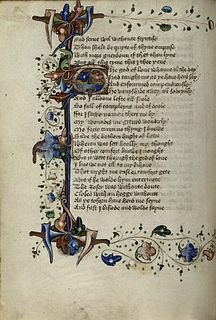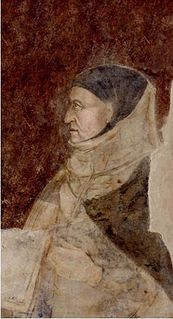Related Research Articles

Geoffrey Chaucer was an English poet, author, and civil servant best known for The Canterbury Tales. He has been called the "father of English literature", or, alternatively, the "father of English poetry". He was the first writer to be buried in what has since come to be called Poets' Corner, in Westminster Abbey. Chaucer also gained fame as a philosopher and astronomer, composing the scientific A Treatise on the Astrolabe for his 10-year-old son Lewis. He maintained a career in the civil service as a bureaucrat, courtier, diplomat, and member of parliament.

Theseus was the mythical king and founder-hero of Athens. The myths surrounding Theseus – his journeys, exploits, and friends – have provided material for fiction throughout the ages.

The Romaunt of the Rose is a partial translation into Middle English of the French allegorical poem, Le Roman de la Rose. Originally believed to be the work of Chaucer, the Romaunt inspired controversy among 19th-century scholars when parts of the text were found to differ in style from Chaucer's other works. Also the text was found to contain three distinct fragments of translation. Together, the fragments—A, B, and C—provide a translation of approximately one-third of Le Roman.

"The Knight's Tale" is the first tale from Geoffrey Chaucer's The Canterbury Tales.

Geoffrey Chaucer presumably never finished "The Cook's Tale" and it breaks off after 58 lines, although some scholars argue that Chaucer deliberately left the tale unfinished. The story starts telling of an apprentice named Perkyn who is fond of drinking and dancing. Perkyn is released by his master and moves in with a friend who also loves to drink, and whose wife is a shopkeeper whose real occupation is that of a prostitute.

The Two Noble Kinsmen is a Jacobean tragicomedy, first published in 1634 and attributed jointly to John Fletcher and William Shakespeare. Its plot derives from "The Knight's Tale" in Geoffrey Chaucer's The Canterbury Tales, which had already been dramatised at least twice before. This play is believed to have been William Shakespeare's final play before he retired to Stratford-upon-Avon and died three years later.

The Book of the Duchess, also known as The Deth of Blaunche, is the earliest of Chaucer's major poems, preceded only by his short poem, "An ABC", and possibly by his translation of The Romaunt of the Rose. Based on the themes and title of the poem, most sources put the date of composition after 12 September 1368 and before 1372, with many recent studies privileging a date as early as the end of 1368.

Walter William Skeat, was a British philologist and Anglican deacon. The pre-eminent British philologist of his time, he was instrumental in developing the English language as a higher education subject in the United Kingdom.
Philostrate is a fictional character in a number of literary works, including William Shakespeare's A Midsummer Night's Dream (1596). In that play, he is the Master of Revels at Theseus' court, meaning he is in charge of his lord's entertainments, making recommendations to Theseus, as well as altering the text of some of the plays performed in his court. Shakespeare may have used this character to poke fun at play censorship in London at the time. In early performances of the play, the actor who played this character probably also played the part of Egeus, Hermia's strict father. There is only one scene in Act V where both Egeus and Philostrate are present, and in this scene Egeus' character would have taken all of Philostrate's lines as his own.
Fables, Ancient and Modern is a collection of translations of classical and medieval poetry by John Dryden interspersed with some of his own works. Published in March 1700, it was his last and one of his greatest works. Dryden died two months later.
Chanticleer and the Fox is a fable that dates from the Middle Ages. Though it can be compared to Aesop's fable of The Fox and the Crow, it is of more recent origin. The story became well known in Europe because of its connection with several popular literary works and was eventually recorded in collections of Aesop's Fables from the time of Heinrich Steinhowel and William Caxton onwards. It is numbered 562 in the Perry Index.

Teseida is a long epic poem written by Giovanni Boccaccio c.1340–41. Running to almost 10,000 lines divided into twelve books, its notional subject is the career and rule of the ancient Greek hero Theseus (Teseo), although the majority of the epic tells the story of the rivalry of Palemone and Arcita for the love of Emilia. It is the main source of "The Knight's Tale" in Geoffrey Chaucer's Canterbury Tales, and therefore is the original source of The Two Noble Kinsmen, a collaboration by William Shakespeare and John Fletcher. The exact sources of Boccaccio's knowledge about the ancient Greek world are unknown, but is likely that he gained the knowledge through his close friendship with Paolo de Perugia, a medieval collector of ancient myths and tales.

Contact between Geoffrey Chaucer and the Italian humanists Petrarch or Boccaccio has been proposed by scholars for centuries. More recent scholarship tends to discount these earlier speculations because of lack of evidence. As Leonard Koff remarks, the story of their meeting is "a 'tydying' worthy of Chaucer himself".
The Floure and the Leafe is an anonymous Middle English allegorical poem in 595 lines of rhyme royal, written around 1470. During the 17th, 18th, and most of the 19th century it was mistakenly believed to be the work of Geoffrey Chaucer, and was generally considered to be one of his finest poems. The name of the author is not known but the poem presents itself as the work of a woman, and some critics are inclined to take this at face value. The poet was certainly well-read, there being a number of echoes of earlier writers in the poem, including Geoffrey Chaucer, John Lydgate, John Gower, Andreas Capellanus, Guillaume de Lorris, Guillaume de Machaut, Jean Froissart, Eustache Deschamps, Christine de Pizan, and the authors of the "Lai du Trot" and the Kingis Quair.
Sir Perceval of Galles is a Middle English Arthurian verse romance whose protagonist, Sir Perceval (Percival), first appeared in medieval literature in Chrétien de Troyes' final poem, the 12th-century Old French Conte del Graal, well over one hundred years before the composition of this work. Sir Perceval of Galles was probably written in the northeast Midlands of England in the early 14th century, and tells a markedly different story to either Chretien's tale or to Robert de Boron's early 13th-century Perceval. Told with a comic liveliness, it omits any mention of a graal or a Grail.

The Tale of Gamelyn is a romance written in c. 1350 in a dialect of Middle English, considered part of the Matter of England. It is presented in a style of rhymed couplets and described by Skeat as "the older and longer kind of ballad" and by Ramsey as a "rough and ready romance."
Palamon and Arcite (1566) is a play by Richard Edwardes, which was performed before Elizabeth I at Oxford. It is based on Chaucer's The Knight's Tale. Though the text of the play is lost, there is a detailed record of its structure and plot.

Anne de Graville or Anne Malet de Graville (c.1490–c.1540) was a French Renaissance poet, translator, book collector, and lady-in-waiting to Queen Claude of France. She hailed from one of the most prominent families in the country, and overcame scandal to become a well respected literary figure at the royal court. In addition to authoring two texts, she was an avid collector of books and manuscripts.
Percival Ashley Chubb (1860–1959) was a founding member of the Fabian Society, an influential British socialist organization that aims to advance the principles of democratic socialism via gradualist and reformist effort in democracies.
References
- ↑ Dryden, J., Chubb, P., Chubb, P., Chaucer, G. (1899). Dryden's Palamon and Arcite: or The Knight's tale from Chaucer. New York: The Macmillan company.
- ↑ Chaucer, G., Skeat, W. W. (Walter William). (1904). The knight's tale: or, Palamon and Arcite. London: Alexander Moring, limited, The De la More press.